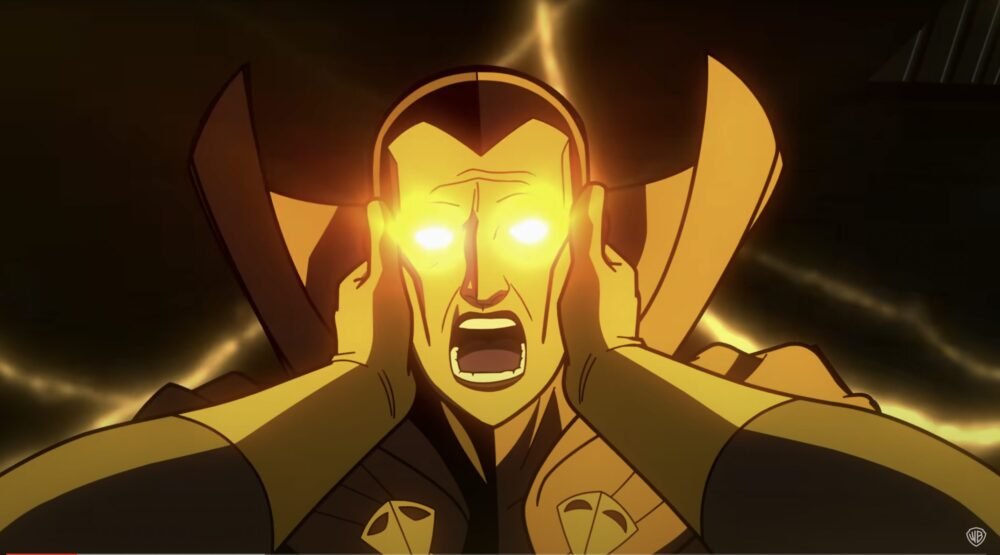By Brandon T. McClure
The Tomorrowverse is coming to an end with a massive three-part adaptation of the seminal comic book event Crisis On Infinite Earths. While Part 1 was an inventive story exploring the Flash's life in the franchise, Part 2 serves little more than to set up the final entry. Directed by Jeff Wamester and written by James Krieg, Justice League: Crisis On Infinite Earths - Part Two picks up after the events of the first film. After stopping the first antimatter wave from destroying the entire multiverse, the heroes find themselves under siege by a horde of shadow creatures. But now the Anti-Monitor is revealing himself to the heroes, and they may not be able to stop him.
"The major selling point of Justice League: Crisis On Finite Earths - Part 2 is the Tomorrowverse Batman (Jensen Ackles) teaming up with a multiverse Batfamily that includes Batgirl (Gideon Adlon), Huntress (Erika Ishii), Batman Beyond (Will Friedle), and a few Robins (Zach Callison), if you don't blink. At least, that’s what the box art and marketing would have you believe. In truth, they have minimal screen time, and the filmmakers seem uncertain how to utilize them effectively. Even the much-hyped return of Will Friedle as Batman Beyond merely serves as set dressing for an underwhelming action sequence. Batwing, mentioned earlier, appears in only one frame of the film, leaving one to wonder if his role was intended to be cut entirely
All that being said, there is an interesting premise at the heart of the Batman sequences. Audiences learned in Justice League: Crisis On Infinite Earths - Part One that Bruce didn’t adopt Dick Grayson when he had the chance because he felt it would be irresponsible. Teaming him up with members of the Batfamily from across the multiverse allows him to see that he may have been wrong in his decision. It enables Batman to reflect on himself and learn what every comic book fan has known for decades: that Batman should never be alone.
Strangely enough, Psycho Pirate (Geoffrey Arend) has more to do in this film than Batman. Audiences learn a lot about Psycho Pirate’s Tomorrowverse history through a series of flashbacks. Audiences learn that he can travel the multiverse thanks to Earth 2’s Dr. Fate (Keith Ferguson), and they discover the events that lead him to becoming a supervillain. By the time the Anti-Monitor (Ato Essandoh) begins to influence him, you’re left wondering why this took so long. In truth, his story is kind of interesting; however, it halts the movie in its tracks whenever it cuts to one of his flashbacks. Therein lies the fundamental issue with the film: its flashbacks.
While Justice League: Crisis On Infinite Earths - Part One expertly used Flash’s time travel abilities to weave each flashback into a cohesive narrative, this film struggles to find a way to make the flashbacks feel organic. Each time the film needs to exposit some backstory, it cuts to a flashback or a flashback within a flashback. It’s a useful narrative device that is used quite lazily in this entry and stalls the pacing of the film (that and the fake accents, but that’s a franchise problem).
However, the film does have a shining light in the form of Supergirl (Meg Donnelly). This film reveals more of what happened to her between the destruction of Krypton and arriving on Earth in Legion of Superheroes. Through the use of, you guessed it, flashbacks, the film reveals a hidden parently relationship between Supergirl and the Monitor (Jonathan Adams). While these flashbacks also ruin the pacing of the film, they feel far more engaging than the ones about Psycho Pirate. You begin to understand how Supergirl was able to change the Monitor for the better, leading to his desire to save the multiverse. Their relationship forms the emotional center of the film and ends up being the true standout. The emotional crescendo of the story is well worth it and packs an emotional punch.
There are some decent moments in the film, like the return of Matt Ryan as John Constantine, but ultimately you’re left wondering if this needed to be a full feature. Or even if there needed to be three parts to this story. You can’t help but shake the feeling that this entry is just filling time before the finale. But now the stage is set for a climactic battle between the heroes of the multiverse and the Anti-Monitor. Hopefully, part three can bring the whole thing home with a satisfying conclusion.
Rating this 6.5/10
For more coverage, check out Brandon’s previous article: The End Of The Tomorrowverse & The Future Of The DC Animated Original Movies




